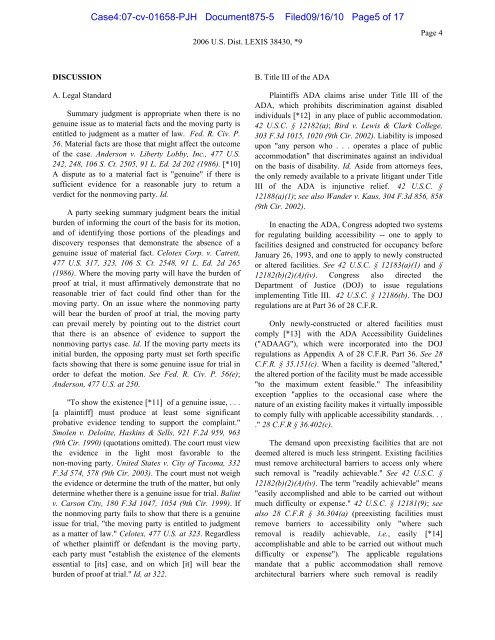exhibit 2 - SAP Lawsuit Portal
exhibit 2 - SAP Lawsuit Portal
exhibit 2 - SAP Lawsuit Portal
Create successful ePaper yourself
Turn your PDF publications into a flip-book with our unique Google optimized e-Paper software.
DISCUSSION<br />
A. Legal Standard<br />
Case4:07-cv-01658-PJH Document875-5 Filed09/16/10 Page5 of 17<br />
Summary judgment is appropriate when there is no<br />
genuine issue as to material facts and the moving party is<br />
entitled to judgment as a matter of law. Fed. R. Civ. P.<br />
56. Material facts are those that might affect the outcome<br />
of the case. Anderson v. Liberty Lobby, Inc., 477 U.S.<br />
242, 248, 106 S. Ct. 2505, 91 L. Ed. 2d 202 (1986). [*10]<br />
A dispute as to a material fact is "genuine" if there is<br />
sufficient evidence for a reasonable jury to return a<br />
verdict for the nonmoving party. Id.<br />
A party seeking summary judgment bears the initial<br />
burden of informing the court of the basis for its motion,<br />
and of identifying those portions of the pleadings and<br />
discovery responses that demonstrate the absence of a<br />
genuine issue of material fact. Celotex Corp. v. Catrett,<br />
477 U.S. 317, 323, 106 S. Ct. 2548, 91 L. Ed. 2d 265<br />
(1986). Where the moving party will have the burden of<br />
proof at trial, it must affirmatively demonstrate that no<br />
reasonable trier of fact could find other than for the<br />
moving party. On an issue where the nonmoving party<br />
will bear the burden of proof at trial, the moving party<br />
can prevail merely by pointing out to the district court<br />
that there is an absence of evidence to support the<br />
nonmoving partys case. Id. If the moving party meets its<br />
initial burden, the opposing party must set forth specific<br />
facts showing that there is some genuine issue for trial in<br />
order to defeat the motion. See Fed. R. Civ. P. 56(e);<br />
Anderson, 477 U.S. at 250.<br />
"To show the existence [*11] of a genuine issue, . . .<br />
[a plaintiff] must produce at least some significant<br />
probative evidence tending to support the complaint."<br />
Smolen v. Deloitte, Haskins & Sells, 921 F.2d 959, 963<br />
(9th Cir. 1990) (quotations omitted). The court must view<br />
the evidence in the light most favorable to the<br />
non-moving party. United States v. City of Tacoma, 332<br />
F.3d 574, 578 (9th Cir. 2003). The court must not weigh<br />
the evidence or determine the truth of the matter, but only<br />
determine whether there is a genuine issue for trial. Balint<br />
v. Carson City, 180 F.3d 1047, 1054 (9th Cir. 1999). If<br />
the nonmoving party fails to show that there is a genuine<br />
issue for trial, "the moving party is entitled to judgment<br />
as a matter of law." Celotex, 477 U.S. at 323. Regardless<br />
of whether plaintiff or defendant is the moving party,<br />
each party must "establish the existence of the elements<br />
essential to [its] case, and on which [it] will bear the<br />
burden of proof at trial." Id. at 322.<br />
2006 U.S. Dist. LEXIS 38430, *9<br />
B. Title III of the ADA<br />
Page 4<br />
Plaintiffs ADA claims arise under Title III of the<br />
ADA, which prohibits discrimination against disabled<br />
individuals [*12] in any place of public accommodation.<br />
42 U.S.C. § 12182(a); Bird v. Lewis & Clark College,<br />
303 F.3d 1015, 1020 (9th Cir. 2002). Liability is imposed<br />
upon "any person who . . . operates a place of public<br />
accommodation" that discriminates against an individual<br />
on the basis of disability. Id. Aside from attorneys fees,<br />
the only remedy available to a private litigant under Title<br />
III of the ADA is injunctive relief. 42 U.S.C. §<br />
12188(a)(1); see also Wander v. Kaus, 304 F.3d 856, 858<br />
(9th Cir. 2002).<br />
In enacting the ADA, Congress adopted two systems<br />
for regulating building accessibility -- one to apply to<br />
facilities designed and constructed for occupancy before<br />
January 26, 1993, and one to apply to newly constructed<br />
or altered facilities. See 42 U.S.C. § 12183(a)(1) and §<br />
12182(b)(2)(A)(iv). Congress also directed the<br />
Department of Justice (DOJ) to issue regulations<br />
implementing Title III. 42 U.S.C. § 12186(b). The DOJ<br />
regulations are at Part 36 of 28 C.F.R.<br />
Only newly-constructed or altered facilities must<br />
comply [*13] with the ADA Accessibility Guidelines<br />
("ADAAG"), which were incorporated into the DOJ<br />
regulations as Appendix A of 28 C.F.R. Part 36. See 28<br />
C.F.R. § 35.151(c). When a facility is deemed "altered,"<br />
the altered portion of the facility must be made accessible<br />
"to the maximum extent feasible." The infeasibility<br />
exception "applies to the occasional case where the<br />
nature of an existing facility makes it virtually impossible<br />
to comply fully with applicable accessibility standards. . .<br />
." 28 C.F.R § 36.402(c).<br />
The demand upon preexisting facilities that are not<br />
deemed altered is much less stringent. Existing facilities<br />
must remove architectural barriers to access only where<br />
such removal is "readily achievable." See 42 U.S.C. §<br />
12182(b)(2)(A)(iv). The term "readily achievable" means<br />
"easily accomplished and able to be carried out without<br />
much difficulty or expense." 42 U.S.C. § 12181(9); see<br />
also 28 C.F.R § 36.304(a) (preexisting facilities must<br />
remove barriers to accessibility only "where such<br />
removal is readily achievable, i.e., easily [*14]<br />
accomplishable and able to be carried out without much<br />
difficulty or expense"). The applicable regulations<br />
mandate that a public accommodation shall remove<br />
architectural barriers where such removal is readily


